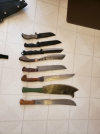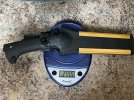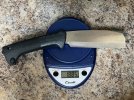coolbreezy37
Gold Member
- Joined
- Aug 28, 2021
- Messages
- 3,343
SwampRat MountainManDu.
The BladeForums.com 2024 Traditional Knife is ready to order! See this thread for details:
https://www.bladeforums.com/threads/bladeforums-2024-traditional-knife.2003187/
Price is $300 ea (shipped within CONUS). If you live outside the US, I will contact you after your order for extra shipping charges.
Order here: https://www.bladeforums.com/help/2024-traditional/ - Order as many as you like, we have plenty.
Or, if you want a lightweight khukri that cuts like crazy......Khukuri. Kailash if you're patient, HI if not






I would make a recommendation based partly on weight.
My choice is Varusteleka Skrama 240, which comes in at 26.1 oz. fully kitted out. Skrama by itself is 18.5 oz.


The blade-only weight of the Silky Nata is 33.5 oz. according to their website.
I want a large blade that is not hugely heavy to carry while still having enough heft to do the job. As choppers, though, maybe the extra weight is what you are looking for. Otherwise, their blades are the same length, they both have good steel, retentive sheaths, similar cost, good grips, and nice finish.
Zieg
220$. I think I'll hold out for a the Storm Vector if possible.Almost bought one for my kitchen - my girlfriend loves it but $300 for it, jeez.
I need a big chopper, Chinese Cleaver esque type thing, so we can cleave through meat and stuff, the Buck 119 won't do it and the Ontario SP-1 is a little too obtuse a grind...
Looking forward to seeing what you decide.220$. I think I'll hold out for a the Storm Vector if possible.
Edit; or the Skrama if my clicker finger gets itchy...
Looking forward to seeing what you decide.
Zieg
Ugh, $220, 220, 220... I paid 2-I-don't-wanna-remember for a Shaman... so this is not out of the question.220$. I think I'll hold out for a the Storm Vector if possible.
Edit; or the Skrama if my clicker finger gets itchy...
For aesthetic reasons, I like the Tops Storm Vector more. I just looked up some vids and they seems to perform about the same. Does anyone know if the one is more comfortable than the other. From pictures, the handle on the Storm looks more round (comfortable) than the El Chete looks square (uncomfortable). Anyone know?
Khukuri. Kailash if you're patient, HI if not

While backpacking during the winter, I mainly use my axe to delimb dead branches, do some light chopping, and even lighter splitting. Over the years I've found pine forests don't require much work to process wood for a fire. Although there are lighter axes on the market, I’m looking at large knives to replace my GFB Small Forest Axe. Something less awkward to swing for delimbing, and potentially use less calories while doing so. With the new potential knife, I would be delimbing, general chopping, and batoning.
I do have the Ontario SP50, which is very nice, I’m looking for an upgrade and the Silky Nata Hatchet has caught my eye. Is there a knife you think excels beyond the two? Also, if you’ve used both, is the Silky Nata worth buying to replace my SP50?

Ooh, the Baryonyx! I forgot about that one. Good choice right there. Can you compare/contrast it to the Skrama for a few sentences for us?The SP50 can be a really competant chopper. All of the Spec plus knives I've received from OKC have had edges thag were far too obtuse. After resetting the edge angle to something more reasonable for work lighter than splitting wood, they are much better, IMO.
The silky nata, IMO, seems a little expensive for what it is. I would rather have a parang or golok at that price. My parang makes some good options, IMO. Parangs are angled in a manner that makes them good for doing work close to the ground, which is normally where you're working around a camp.
In the unlikely chance you're located around SE MI, I would be happy to meet you with some choppers to mess with.
I also wouldn't underestimate some cheaper options like bolo machetes. They're pretty decent at limbing. Their main downside is they often have no useful edge when bought and the handles can be uncomfortable, so you usually need to put some time into them. Something like a kershaw camp 10 would be a decent alternative too. A parang would still be my preference though.
Parangs and kuhkri's often serve a similar purpose as a heavy bladed tool. I just don't love kukris as the blade likes to turn on me. I'm sure itnhas to do with how I swing them, but I don't experience that with parangs so I just use them now.
The skrama 240 is also very capable.
View attachment 1871958
Ooh, the Baryonyx! I forgot about that one. Good choice right there. Can you compare/contrast it to the Skrama for a few sentences for us?
Zieg
Excellent writeup! Thanks!They're really nothing alike, but I can give it a go.
The baryonyx, which I've used more, is a heavy working machete with both a slightly curving primary edge and a billhook on the back side. It's easier to use the hook edge than some like the condor swamp master or viking machete. It works as a machete but is heavy enough to do some good chopping. The downside of the weight is that it is hard on the arms to do a lot of area of light vegetation like you can with a latin. It's the compromise of having a lot of versatility in a single blade.
The skrama is much thicker and shorter. The handle is much more comfortable for chopping. It is the better wood processor and it doens't stick in wood as badly as the baryonyx since it's wider steel pops chips better. Fine work is easier with the skrama because of the handle and balance when choked up. The baryonyx is much more blade heavy, even choked up. The skrama carries much, much easier too as the baryonyx is very broad.
The baryonyx would make a decent many purpose tool for a vehicle but is very awkward to pack for things like backpacking, canoeing, etc. The skrama, in my mind, isn't a ton different than a BK9 in the wood processing department. I like the skrama's handle more. The skrama sucks for food though, even thr skrama 80 wasn't a good food prep tool. Good for crafting and wood processing, but the lack of belly wasn't enjoyable for food work and the grinds didn't lend themselves to slicing well. The baryonyx would be awkward because of the size but I would prefer it for food processing or processing medium or large game.
FYI Silky makes a small Nata too, but it’s a little tricky to find.I would make a recommendation based partly on weight.
My choice is Varusteleka Skrama 240, which comes in at 26.1 oz. fully kitted out. Skrama by itself is 18.5 oz.


The blade-only weight of the Silky Nata is 33.5 oz. according to their website.
I want a large blade that is not hugely heavy to carry while still having enough heft to do the job. As choppers, though, maybe the extra weight is what you are looking for. Otherwise, their blades are the same length, they both have good steel, retentive sheaths, similar cost, good grips, and nice finish.
Zieg


